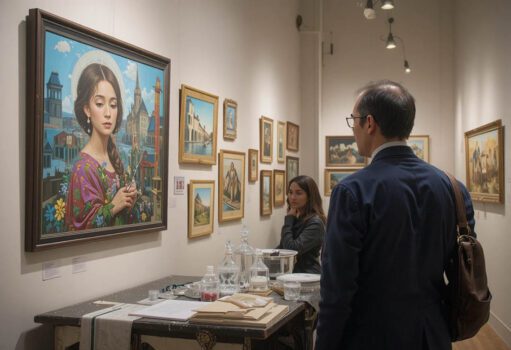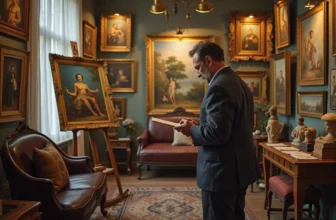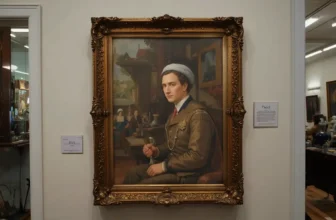How Art Safeguards Your Money in Times of Inflation
Shopping Ads: Invest in Hidden Masterpiece: Rare Antique Oil Paintings For Sale. Limited Originals Available 💰😊 Are you looking for authentic hidden masterpiece? Explore old master antique oil paintings from the Renaissance and Baroque eras. From 16th-century portraits to 18th-century landscapes. Authenticity guaranteed, Old Master antique oil paintings for sale. Shop Now! 🎨 Renaissance And Baroque Art Old Master Portrait Paintings Landscape Antique PaintingsInflation has always been one of the most challenging economic realities for investors, savers, and anyone looking to preserve wealth over time. When the purchasing power of money decreases, traditional investments such as savings accounts or bonds may not provide sufficient returns to outpace rising prices. In these conditions, alternative assets, especially fine art, often emerge as powerful tools for wealth preservation. But how exactly can art investment protect you from inflation, and why are high-net-worth individuals increasingly turning to it as a financial shield?
In this comprehensive, 2200-word SEO-optimized guide, we’ll explore the relationship between inflation and art investment, uncover the historical data behind art’s resilience, explain the economic mechanisms that make art a hedge against inflation, and offer practical insights into how to invest in art wisely.
Understanding Inflation and Its Impact on Wealth
Before we explore how art helps mitigate inflation risk, it’s crucial to understand what inflation is and how it erodes wealth.
Inflation refers to the general rise in prices of goods and services over time. It diminishes the value of money, what you can buy today for €100 might cost €110 or more in the near future. Central banks often target moderate inflation to encourage spending and investment, but when inflation spikes, it destabilizes markets and erodes returns on cash and fixed-income assets.
During inflationary periods:
Cash loses value. Savings accounts and low-interest bonds cannot keep up with the inflation rate.
Equity markets fluctuate. Stocks may react unpredictably depending on corporate profitability and consumer demand.
Real assets gain value. Tangible assets like real estate, gold, and fine art often appreciate because they have intrinsic, finite value.
This last category, real assets, is where art becomes particularly compelling.
Why Art is Considered a Hedge Against Inflation
Art, as an asset class, behaves differently from financial instruments. Its value is not directly tied to corporate earnings, interest rates, or short-term market sentiment. Instead, it’s determined by factors like rarity, artist reputation, provenance, and cultural significance.
There are several key reasons why art can protect investors from inflation:
A. Art Is a Tangible Asset with Finite Supply
Unlike currency, which governments can print at will, the supply of art is inherently limited. There will never be another original Van Gogh, Picasso, or Monet. This scarcity gives art intrinsic value that cannot be diluted by monetary policy.
During times of inflation, investors often seek tangible assets that are immune to currency devaluation. Fine art, like gold or real estate, provides a physical store of value independent of national economies.
B. Art Prices Are Less Correlated with Stock Markets
Historical analysis shows that art prices move largely independently of traditional markets. When equities fall due to inflationary pressure, art prices often remain stable or even rise.
For example, data from the Artprice100® Index and Masterworks.io reports reveal that between 1973 and 1981, an era of high inflation, fine art outperformed the S&P 500 by a significant margin. This low correlation helps diversify an investor’s portfolio and reduce exposure to systemic financial risks.
C. Art Appreciates Over Time
Unlike most consumer goods that depreciate, high-quality art can appreciate for decades or even centuries. As artists gain recognition or as demand for their work grows, the value of their art typically rises. Many masterpieces have multiplied in price tenfold or more since their original sale.
Thus, art acts as a long-term store of value that not only protects against inflation but may also outperform traditional investments in the long run.
Historical Evidence: Art’s Performance During Inflationary Periods
To understand art’s protective qualities, we can look at historical trends.
A. The 1970s Inflation Boom
The 1970s were marked by soaring inflation due to oil crises and economic instability. While financial markets struggled, the art market flourished. Auction records from Sotheby’s and Christie’s during this period show substantial price increases for works by modern masters like Monet, Renoir, and Picasso.
Collectors viewed art as a safe haven, a physical asset that retained value while currencies weakened. In fact, art prices rose approximately 10–15% annually during peak inflation years, significantly outpacing consumer price inflation rates.
B. The 2008 Financial Crisis
During the global recession, while many investment portfolios suffered steep losses, blue-chip art, particularly works by established artists, proved resilient. The Mei Moses Fine Art Index, which tracks the performance of repeat art sales, showed that the art market recovered faster than most stock indices.
This historical resilience demonstrates that art can serve not only as an inflation hedge but also as a stability anchor during broader economic crises.
The Economics Behind Art’s Inflation Hedge
Art’s ability to protect against inflation can be understood through economic fundamentals: scarcity, demand, and cultural value.
A. Scarcity and Value Retention
Because the creation of authentic fine art is limited, its supply cannot be increased to meet inflationary demand. This scarcity ensures that each piece maintains a level of exclusivity and desirability that inflation cannot erode.
B. Global Demand
Art markets operate globally. Wealthy collectors from the U.S., Europe, Asia, and the Middle East all participate, often competing for the same pieces. As global wealth grows, so does demand for fine art, which exerts upward pressure on prices even during inflationary cycles.
C. Emotional and Cultural Value
Art is not just a financial asset, it carries aesthetic, emotional, and cultural worth. This multi-dimensional value offers protection that purely financial assets lack. People buy art not only for investment but for prestige, enjoyment, and legacy, motivations that persist regardless of inflation levels.
Types of Art Investments Suitable for Inflation Protection
Not all art investments behave equally during inflationary periods. To use art effectively as a hedge, investors should focus on certain categories that historically perform well.
A. Blue-Chip Art
Blue-chip art refers to works by renowned artists with established market histories, Picasso, Warhol, Rothko, Basquiat, Monet, and others. These pieces are highly sought after, relatively stable in value, and tend to appreciate steadily over time.
Such art often serves as the core inflation-hedge asset for collectors and investors.
B. Contemporary and Emerging Artists
Investing in emerging or mid-career artists can yield higher returns but comes with higher risk. However, during inflation, collectors often turn toward new artists whose works are still accessible but may increase in value as recognition grows.
C. Art Funds and Fractional Ownership
For those who cannot afford to buy entire paintings, art investment funds and fractional ownership platforms allow participation in the art market. These vehicles pool investors’ capital to acquire high-value artworks, providing both liquidity and diversification.
D. Digital and NFT Art
Although the NFT market experienced volatility, certain rare digital works tied to reputable artists have shown resilience. As the digital economy evolves, NFTs could become another inflation-protected art form due to their blockchain-verified scarcity.
How to Invest in Art to Beat Inflation
If you’re considering art as a shield against inflation, strategic investment is essential. Here’s a step-by-step guide.
Step 1: Define Your Investment Objectives
Determine whether you’re seeking long-term wealth preservation, portfolio diversification, or speculative returns. Your goals will shape what kind of art you buy and at what price level.
Step 2: Research Market Trends
Use databases such as Artprice, Artnet, or Sotheby’s reports to analyze art market trends. Pay attention to artists whose works consistently appreciate and whose demand spans across different geographies.
Step 3: Prioritize Quality Over Quantity
Focus on acquiring one high-quality piece rather than several mediocre ones. Quality artworks from recognized artists tend to hold value and attract buyers even during economic uncertainty.
Step 4: Verify Provenance and Authenticity
Inflation drives demand, which can also lead to forgery risks. Always verify authenticity through documentation, provenance records, and, when possible, gallery or museum references.
Step 5: Buy from Reputable Sources
Work with respected galleries, established auction houses, or verified art advisors. Their expertise helps ensure fair valuation and minimizes fraud risks.
Step 6: Diversify Across Art Categories
Don’t limit your portfolio to one type of art. Include modern, post-war, and contemporary works to spread risk and maximize resilience against inflation-driven market changes.
Step 7: Plan for Storage and Insurance
Preserving the physical condition of your artwork is crucial to maintaining its value. Store it in climate-controlled environments and insure it through specialized art insurance policies.
7. Tax and Financial Advantages of Art During Inflation
Art ownership can also provide financial and tax advantages that enhance its appeal during inflationary times.
A. Deferred Capital Gains
Art typically appreciates over long periods. Because it’s not a liquid asset, investors often hold it for years or decades, naturally deferring capital gains tax until the artwork is sold.
B. Estate and Wealth Planning
Art can serve as a store of wealth for future generations. High-value artworks can be transferred, loaned to museums, or held in trusts as part of estate planning strategies.
C. Collateral for Loans
In times of inflation, liquidity becomes valuable. Many financial institutions accept fine art as collateral for loans, allowing investors to access capital without selling their assets.
The Role of Art in a Diversified Inflation-Proof Portfolio
An inflation-proof investment portfolio combines multiple asset types to balance risk and return. Art plays a complementary role alongside gold, real estate, and inflation-indexed bonds.
A. Portfolio Diversification
Including art reduces exposure to traditional financial assets that suffer during inflation. Its low market correlation ensures portfolio stability and smoother long-term performance.
B. Long-Term Preservation
Unlike stocks, which can lose value overnight, high-quality art typically maintains demand over decades. Its value is rooted in cultural heritage rather than market volatility.
C. Emotional and Social Returns
Unlike most investments, art provides aesthetic satisfaction, prestige, and cultural engagement, unique “dividends” that go beyond financial performance.
Risks and Limitations of Art as an Inflation Hedge
While art investment offers numerous benefits, it’s not without risks.
A. Illiquidity
Art is not easily sold on short notice. Finding the right buyer at the right price can take months or even years.
B. Market Volatility
While the top-tier art market is relatively stable, mid-tier and emerging art categories can experience significant price swings depending on collector trends and media influence.
C. High Transaction Costs
Auction fees, insurance, transport, and storage can significantly increase total investment costs. These expenses must be considered in your return expectations.
D. Lack of Standardized Valuation
Unlike stocks or bonds, art lacks a standardized valuation system. Pricing depends on subjective factors, which can complicate financial planning.
Despite these challenges, art remains one of the few assets with both tangible and cultural value, qualities that make it resilient during inflationary periods.
Case Studies: How Art Protected Wealth During Inflation
Case 1: The Warhol Example
In the 1980s, inflation and market volatility were high, yet Andy Warhol’s works skyrocketed in value. “Marilyn Monroe (Shot Sage Blue Marilyn)” sold in 2022 for over $195 million, an appreciation far exceeding inflation over the same period. Collectors who invested early preserved and multiplied their wealth.
Case 2: Post-War Abstract Expressionism
Collectors who acquired works by Mark Rothko, Jackson Pollock, or Willem de Kooning in the mid-20th century saw exceptional appreciation. As inflation devalued currencies in the 1970s, these paintings became coveted safe-haven assets.
Case 3: The Contemporary Art Boom
From 2000 to 2020, even as inflation fluctuated globally, artists like Banksy, Yayoi Kusama, and Gerhard Richter saw exponential growth in demand. The art market’s ability to adapt to new tastes and technologies made it consistently attractive during inflationary cycles.
How Technology Is Enhancing Art’s Inflation Hedge Potential
Modern technology is transforming the accessibility and transparency of art investing, making it an even stronger inflation hedge.
A. Blockchain and Provenance Verification
Blockchain technology helps verify authenticity and track provenance, reducing fraud and increasing confidence among investors. This transparency strengthens the investment value of art during volatile markets.
B. Fractional Investing Platforms
Companies like Masterworks allow investors to buy fractional shares of masterpieces. This democratizes access to the art market and enables smaller investors to benefit from art’s inflation-resistant nature.
C. AI-Powered Market Analytics
Artificial intelligence can analyze art market trends, predict appreciation potential, and assess historical correlations between inflation and art prices, empowering smarter investment decisions.
The Psychological Factor: Why Investors Trust Art During Inflation
When economic uncertainty rises, investors often seek assets that feel real, permanent, and meaningful. Art provides psychological reassurance, something beyond numbers and charts.
Owning art conveys stability, taste, and a sense of permanence that abstract financial assets lack. In uncertain times, that emotional connection drives continued demand, sustaining art’s value and reinforcing its status as a safe haven.
Why Art Investment Remains a Reliable Shield Against Inflation
Art investment is more than just a passion for aesthetics, it’s a sophisticated wealth strategy. As inflation erodes the purchasing power of money, tangible and culturally significant assets like fine art provide a buffer that preserves real value over time.
By combining scarcity, emotional value, and independence from financial markets, art stands as one of the most resilient forms of investment in uncertain economic climates. While it requires patience, research, and careful curation, the rewards, both financial and personal, are unparalleled.
Key Takeaways
Art is a tangible, finite asset that cannot be printed or replicated like currency.
Historical performance shows that art outpaces inflation and even stocks during economic turmoil.
Diversification and quality are essential to using art effectively as an inflation hedge.
Technological innovations like fractional ownership and blockchain are making art investing more accessible.
Emotional, cultural, and aesthetic value further enhance art’s resilience as a store of wealth.
So, how can art investment protect you from inflation?
By offering scarcity, stability, and timeless value, fine art acts as a financial and emotional fortress. In an age when currencies fluctuate and markets evolve unpredictably, investing in art provides a hedge not only against inflation but against uncertainty itself.
From centuries-old masterpieces to cutting-edge contemporary works, art continues to do what it always has, hold its value when money cannot.




